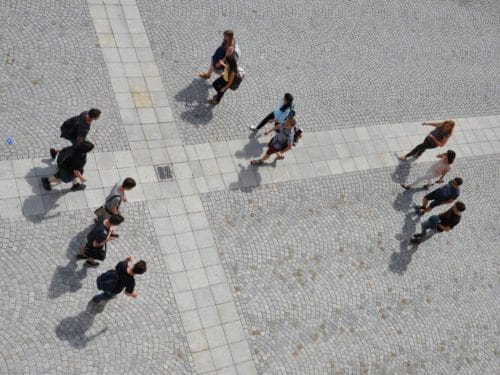For a long time, mathematical modelling of social systems and dynamics was considered in the realm of science fiction. But predicting, and at once influencing human behavior is well on its way to becoming reality. Scientists at the Technical University of Munich (TUM) are currently developing the appropriate tools. This will allow them to simulate and improve security at major events or increase the efficiency of evacuation measures.
There is a long history of research aimed at predicting the behavior of groups and influencing them. But, it seems practically impossible to precisely predict the behavior of individuals, not least because of the myriad interactions between the physical, emotional, cognitive and social domains.
But things look quite different when considering people in traffic, in social networks and at major events in which they do not appear as individuals, but rather as part of a crowd. “People in masses behave akin to particles in a fluid or gas,” explains Professor Massimo Fornasier, chair of the Department of Applied Numerical Analysis at TU Munich.
Analogy to physics
In physics, it is not necessary to know the properties of every individual particle to calculate with a high probability the direction of flow of a large number of gas molecules. It is enough to understand their mean motion properties.
“We can take the same approach when looking at flows of human masses, animal swarms or interacting robots: Analogous to the force of attraction between molecules in a gas, we can describe generalized behavioral patterns as resulting from interacting social forces between individual agents and represent them in mathematical equations,” says Fornasier, describing his approach.
Calculating collective behavioral patterns
Professor Fornasier and his team have recently proven mathematical statements that demonstrate how surprisingly easy it is to automatically generate precise models for specific, relatively simple group interactions based on observed dynamics data.
Using computer simulations, the mathematicians can describe potential collective behavioral patterns of a large number of individuals who mutually influence each other in a given situation. “In the next step we can then also make predictions about future behavior,” says Fornasier. “And once we can calculate the behavior of a group of interacting agents in advance, we are only one small step away from controlling them.”
Informed agents follow the “herd instinct”
In an experiment conducted in May 2015 in collaboration with Consiglio Nazionale delle Ricerche (CNR) and the University of Rome „La Sapienza” in Italy, Fornasier and his team demonstrated that the process is in fact amenable to influencing group behavior.
To this end, the researchers assigned two groups of 40 students each the task of finding a specific location in a building. The scientists planted two incognito informed agents into one of the groups. By merely moving very determinedly in a predefined direction, the agents were able to steer the group toward the target spot.
This experiment demonstrates that taking control of self-organizing systems, which also include groups of individuals, is possible with surprisingly little effort. The mathematicians also confirmed that the results apply equally well to very large groups. “In fact, two to three agents per 100 individuals are sufficient,” says Massimo Fornasier.
Herding dog strategy for opinion forming
The fact that his mathematical models are formulated in an entirely abstract environment makes them easily adaptable to a wide variety of situations. This facilitates finding efficient solutions for steering large masses of people though buildings in a stress-free manner or evacuating people in emergency situations.
“But we can also apply our results to other interesting domains in society, like the behavior of investors in financial markets,” says Fornasier. There, precisely coordinated activities by big investors can result in sizable market movements.
Opinion forming in groups also builds on the interactions of people. In their models, the mathematicians demonstrated that it is most effective to concentrate on the most radical defenders of a given opinion. If you manage to convince them, the rest of the group will follow.
“There is also a good model for this in nature,” according to Fornasier. “To drive a herd of sheep in a desired direction, a good herding dog will always concentrate on the animal that is the farthest removed from the group. They achieve their goal by reining in the most stubborn animal.”
Limits of prediction
“For all the conceivably good application scenarios there remains, of course, the question of abuse,” says Professor Fornasier. “The good news in this context is that we have also proven that behavior is not so easy to predict or control for all kinds of dynamics and situations.”
“An important prerequisite for for predictability and controllability is that the myriad possible interactions between the agents in a large group can be reduced to a small number of effective ones,” says Massimo Fornasier. “Forecasts function well in groups that show generalized patterns of behavior.”
However, with competing interactions, when the energy of individual agents is too large an equilibrium and, thus, concerted movement of the group of agents can no longer be imposed using simple, sporadic interventions.
“An extensive forecast of events like that accomplished by the mathematician Hari Seldon in Isaac Asimov’s Foundation series or the all-encompassing control exercised in Aldous Huxley’s ‘Brave New World’ will remain science fiction,” says Professor Fornasier.


